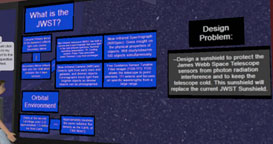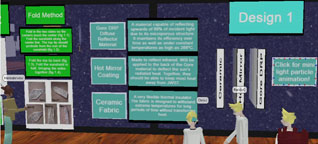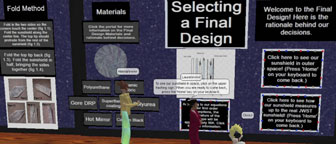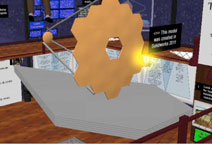Informal Education Resources

OPTIMUS PRIME Spinoff Promotion and Research Challenge (OPSPARC) 2011-2012

More than 400 middle and high school students from across the nation were involved in the RealWorld phase of RWIW for 2012-2011. This is a 400% increase over the 2010-2011 challenge.
RealWorld teams came from middle school academic and engineering schools, high school academic and CTE programs, informal settings such as Chabot Space and Science Center, home school settings, and specialized programs such as Project Lead the Way and NASA INSPIRE. InWorld Teams were mentored by college students representing Ohio State, NC State, Virginia Commonwealth University, Keller University, University of Chattanooga, Rice University, Purdue University, University of Florida, University of Wisconsin, University of Tennessee Space Institute, and Texas A&M._strau
The winning JWST design team is Team Kepler. This team was mentored by Ben Klamm, a graduate student of aerospace engineering at the University of Tennessee Space Institute. His high school team included Ryan Chew (Foster City, CA), Hannah Mohr (Grant, AL), and Lauren Shum (Long Island, NY), all NASA INSPIRE students. You can view a video of their final evaluation and below are some screenshots of their project.
When asked about RWIW, Ben Klamm, the Team Leader described the challenge this way:
“The RealWorld-InWorld challenge represents a necessary step in the education of a true engineer. Project experience is invaluable, and the more experience one gains in an environment that allows risks to be taken and possible failure, the better one is, as an engineer, at effectively dealing with future problems where failure is often a very expensive, and sometimes deadly, outcome.
This challenge, specifically, honed my communication and leadership skills by forcing me to coordinate and delegate tasks completely by correspondence, over multiple time zones. Motivating team members by email is surprisingly difficult, and I gained valuable insight towards this ability.
My student team members garnered insight into the engineering process, including their first real taste of what professional engineers expect from themselves and their peers. During the challenge, critical thinking skills were tested, background research was required, analyses performed, teamwork was coordinated, and results were presented. These are most of the basic tenets that exist during a team project.”
Two of student team members from Team Kepler described their work in RWIW below:
Ryan Chew:
“The RWIW Challenge demands that you become focused and it became a part of my daily schedule. I am very glad that I participated, as this challenge exposed me to new concepts and experiences that I would not have encountered in my local school.
I would highly recommend RWIW to other students! This Challenge integrates teamwork, communication, math and science problem-solving skills, data analysis and 3D modeling all into a month-by-month project. You're able to see and track your team's progress--it's a great and lively experience.
Throughout RWIW I gained valuable problem-solving and organizational skills. 3D modeling was also exciting to learn, as well as the whole "virtual world" building. The Challenge gave me insight as to how NASA takes on and solves many more difficult problems in the real world.”
Lauren Shum:
“I was attracted first to the RWIW Challenge by mere virtue of the fact that it was a challenge-I enjoy a good challenge. I was hooked in even more though when I realized I recognized the program that Challenge participants would be using if they progressed "in world." I had used Activeworlds before to build virtual museum exhibits for the New York Hall of Science; I got excited when I saw it.
If you're considering a STEM career, or perhaps if you're just casually interested in STEM subjects, the RWIW Challenge is for you—it gets you to think like a scientist and build like an engineer... only, you're building virtually!
This challenge has given me practice in thinking critically and solving problems. It has given me confidence in my abilities and my work. It has given me a glimpse-my first taste-of the engineering process and has thereby strengthened my desire to pursue an engineering career.”
What is RealWorld/InWorld?:
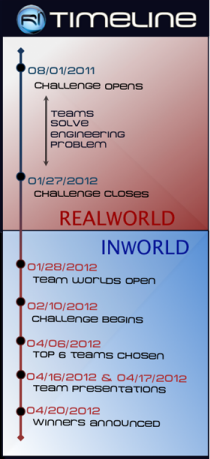
There were two phases to the RWIW Challenge in 2011/2012.
The challenge began in the RealWorld where students in grades 7-12 use the engineering design process to solve a problem related to either the James Webb Space Telescope or Robonaut 2 (R2). Selected RealWorld teams are mentored InWorld by college engineering students in a virtual world setting. Team leader and student InWorld resources are now available.
Throughout both the RealWorld and InWorld phases, Webb Telescope and R2 researchers will meet students in the RWIW STEM Public Space for scheduled Q&A sessions.
RealWorld-InWorld Registration is now open for teachers, students, and college team leaders!
http://www.nasarealworldinworld.org/
For RealWorld Teams, registration has two easy steps:
Step One: Teachers/Coaches/Parents register themselves
Step Two: Teachers/Coaches/Parents register each RealWorld student team
For College Students Registering to become InWorld Team Leaders, registration has one easy step.
Winter 2011 Guest Speakers:
- Thursday, Dec 1, 2012, 4-5p.m. ET - Don McCarthey, NIRCAM Science Team.
- Thursday, Dec 8, 2012, 4-5 p.m. ET - Richard Lynch, Spacecraft Manager.
- Wednesday, Dec 14, 2012, 4-5 p.m. ET - Paul Geithner, Deputy Project Manager.
- Thursday, Dec 15, 2012, 4-5 p.m. ET - Amber Straughn, Research Scientist and Deputy Project Scientist for Education/Outreach

